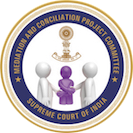History of Mediation
Mediation in India dates back to the Vedic age. In ancient days, disputes were resolved in Panchayat at community level by Panch Parmeshwar, who acted as neutral third party. With the onset of British colonial rule, mediation began to be recognized as a a formal and legalised Alternative Disputes Resolution mechanism.Supreme Court also started reforms in the Indian Judicial System when Hon’ble Mr. Justice A.M. Ahmadi, the then Chief Justice of India invited Institute for the Study and Development of Legal System (ISDLS) to India for a national exchange programme between India and USA. The problems of institutional backlogs were examined in the Indian justice delivery system and certain structural and legislative reforms were suggested which resulted in the introduction of the Code of Civil Procedure (Amendment) Act, 1999 which amended section 89 of the CPC with effect from 1.7.2002 whereby mediation was envisaged as one of the modes of settlement of disputes. This amendment was made on recommendation of Law Commission of India and Justice Malimath Committee. Justice Malimath Committee recommended making it obligatory for the Court to refer the dispute, after issues are framed, for settlement either by way of Arbitration, Conciliation, Mediation or Judicial Settlement through Lok Adalat. In case disputes fail to get resolved through any of the Alternative Dispute Resolution methods, then the suit could proceed further. Thus Section 89 has been introduced to promote alternative methods of dispute resolution.
Hon'ble Mr. Justice R.C. Lahoti, the then Chief Justice, Supreme Court of India constituted a Mediation and Conciliation Project Committee on 09.04.2005 by an administrative order, under the Chairmanship of Hon'ble Mr. Justice N. Santosh Hegde to oversee effective implementation of mediation and conciliation in country.




